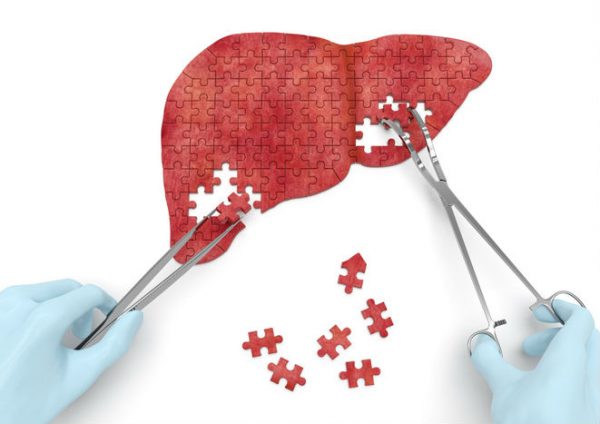
Biotech company 89bio has data from a mid-stage study showing its NASH drug candidate led to improvement on two measures of the fatty liver disease, results that position the molecule to advance to Phase 3 testing.
89bio said Wednesday that two of the three doses of its drug led to improvement in the fibrosis, or liver scarring, characteristic of non-alcoholic steatohepatitis, more commonly referred to as NASH. Each of those two doses also showed resolution of NASH without any worsening of disease symptoms. Both measures are key because they are consistent with FDA guidance on what the regulator is looking for from potential treatments for NASH, a disease with no approved therapies.
In NASH, the buildup of fat leads to inflammation and fibrosis that damages the liver, leading to worsening organ function. Current treatment is mainly diet and lifestyle changes. In advanced cases, a patient may require a liver transplant.
89bio aims to treat NASH by tapping into a way that the body modulates metabolism. The biotech’s drug, pegozafermin, is an engineered version of fibroblast growth factor 21 (FGF21), a cell signaling protein in the body that regulates how cells manage the production and expenditure of energy as well how it metabolizes fats. 89bio engineered its drug using technology that extends its half-life while also maintaining its potency.
The placebo-controlled Phase 2b study was designed to evaluate three different doses of the subcutaneously injected drug. Total enrollment in the 24-week study was 219 patients. The low and middle doses were tested with once weekly dosing. The high dose was administered every two weeks.
On the first of the two main study goals of showing at least one-stage of fibrosis improvement without any worsening of NASH, 89bio said 27% of patients in the high dose group and 26% of those in the middle dose group achieved that mark. By comparison, 7% of patients achieved the goal. The second main goal was to show a resolution of the signs of NASH without worsening of fibrosis. 89bio reported that 26% in the high dose group and 23% in the middle dose group achieved that goal, versus 2% of those in the placebo arm.

A Deep-dive Into Specialty Pharma
A specialty drug is a class of prescription medications used to treat complex, chronic or rare medical conditions. Although this classification was originally intended to define the treatment of rare, also termed “orphan” diseases, affecting fewer than 200,000 people in the US, more recently, specialty drugs have emerged as the cornerstone of treatment for chronic and complex diseases such as cancer, autoimmune conditions, diabetes, hepatitis C, and HIV/AIDS.
Across all doses tested, the most frequent treatment-related adverse effects were gastrointestinal problems, such as diarrhea, nausea, and increased appetite. 89bio described these events as mostly mild to moderate. Five patients stopped treatment due to treatment-related adverse events; no discontinuations happened in the placebo group. One drug-related serious adverse event was reported, a case of uncomplicated pancreatitis in the high dose group. 89bio said this case resolved after a short time.
The efficacy results were confirmed by liver biopsies scored independently by three blinded pathologists to counteract potential bias and variability in the scoring. The FDA now requires this analysis for NASH drugs, a new layer of testing that was added after the agency rejected Intercept Pharmaceuticals NASH drug candidate, obeticholic acid, in 2020. Taking a different approach than 89bio’s drug, obeticholic acid is designed to bind to and activate FXR, a receptor found in cells of the liver and intestine that regulates pathways associated with bile acid, inflammation, fibrosis, and metabolism.
Last July, Intercept reported additional data that included liver biopsy analysis. The FDA accepted the biotech’s new drug application in January, setting a June 22 target date for a regulatory decision. But the drug must first go through an FDA advisory committee meeting, which is scheduled for May 19. Meanwhile, Madrigal Pharmaceuticals is preparing an application seeking accelerated FDA approval of its NASH drug candidate, resmetirom. In December, the biotech reported positive preliminary Phase 3 data for its drug, a small molecule is designed to bind to thyroid hormone receptor beta.
The closest rival to 89bio might be Akero Therapeutics. Akero’s efruxifermin is a fusion protein designed to serve as an analog for FGF21. Last September, Akero reported positive preliminary data from mid-stage tests of the drug, dosed as a once-weekly injection. The company has said data from an expansion cohort are expected in the next quarter; full study results could come in the fourth quarter of this year.
89bio might be able to stand out by providing a different dosing option. In an investor presentation, the company said it is the only company developing an FGF21 analog with options for either weekly or every two weeks dosing. Citing its own market research, 89bio said 63% of type 2 diabetes patients prefer or strongly prefer every two week dosing over weekly injections.
“We are pleased to see that every-two-week dosing produced remarkably similar results to weekly dosing, which is expected to provide us optionality as we work with the FDA to advance pegozafermin into Phase 3 development,” 89bio Chief Medical Officer Hank Mansbach said in a prepared statement.
Photo: Sakramir, Getty Images












